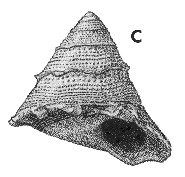
Revised descriptions of New Zealand Cenozoic Mollusca from Beu and Maxwell (1990)

 | Revised descriptions of New Zealand Cenozoic Mollusca from Beu and Maxwell (1990) | 
|
  (Pl. 24c): GS9723, N2/f7594, Paratoetoe, north shore, Parengarenga Harbour, Altonian (GNS) |
Beu & Maxwell (1990): Chapter 11; p. 219; pl. 24 c.
Classification: Turbinidae: Turbininae
Description: Large for subgenus (height about 40 mm, greatest diameter 41 mm), trochiform; spire tall, conic, almost flat-sided, apex flattened. Protoconch of little more than 1 smooth whorl. Teleoconch of 6-7 whorls, first whorl planorboid, later whorls descending; periphery of last whorl sharply angled with short, thick solid spines protruding outward and downward; base very weakly convex with smooth, flat umbilical area occupying central half. Suture undulating strongly around bases of former spines. Sculpture of several rows of very small, rounded granules, largest just below suture, very fine in mid-whorl and just above periphery; outer third of base with fine, regular, undulating spiral threads and similar radial threads. Aperture oval, with strongly curved columella, and excavated lower lip; outer lip swinging strongly forward from periphery then curving up to pass almost straight to suture. Operculum relatively small (compared with G. (Guildfordia) of similar diameter), thin and flat, with rounded margin and exceedingly faint "finger-print" sculpture.
Comparison: This unnamed species is larger and has a much taller and narrower spire and larger peripheral spines than G. (Opella) subfimbriata (Otaian-Altonian, Pakaurangi Point), the type species of Opella Finlay, 1926, and is one of the most elegant of all Turbinidae. These two typical, tall-spired species of Opella resemble typical Guildfordia in almost all characters, especially the details of arrangement of sculptural granules, and of peripheral spines in relation to the peripheral keel; the only important distinguishing points are the much taller, flatter-sided spire and the shorter spines compared with Guildfordia (sensu stricto), and the absence of a hollow in the basal callus. We therefore follow Beu & Ponder (1979, p. 4) and treat Opella as a subgenus of Guildfordia. Opella appears to be an endemic New Zealand taxon. Marwick (1934, p. 11) named as Opella hendersoni a much lower-spired but still conic, beautifully gemmate species from Tarakohe cement quarry, Takaka, Northwest Nelson (Altonian), and a few similar specimens are known from Clifden (Lillburnian); they closely resemble some of the living Western Pacific short-spined species of Guildfordia (sensu stricto) such as G. monilifera (Hedley & Willey 1896, p. 107). It is difficult to decide whether O. hendersoni should be referred to G. (Guildfordia) or G. (Opella); we retain it in G. (Opella) because it has a flat base, lacking a central hollow, and very short peripheral spines. A further small, unnamed species of G. (Opella) is represented by a few specimens in Auckland Museum from the Waitakere Ranges, Auckland (Otaian ?) that are similar to, but shorter than G. (Opella) subfimbriata.
Magne & Vergneau-Saubade (1971) provided the new name Astraea suteri for G. subfimbriata because of supposed secondary homonymy with "Astraea" subfimbriata (Cossmann and Peyrot, 1916) but the replacement name was unnecessary, as Bolma subfimbriata Tournouer in Cossmann and Peyrot, 1916 had not previously been referred to Astraea, and clearly belongs in Bolma (Bolma).
Distribution: Altonian, Paratoetoe and Te Pokere, north shore of Parengarenga Harbour, moderately common in siltstone of probable outer shelf or upper bathyal facies.
Cite this publication as: "A.G. Beu and J.I. Raine (2009). Revised
descriptions of New Zealand Cenozoic Mollusca from Beu and Maxwell (1990). GNS
Science miscellaneous series no. 27."
© GNS Science, 2009
ISBN
978-0-478-19705-1
ISSN 1177-2441
(Included with a PDF facsimile file
copy of New Zealand Geological Survey Paleontological Bulletin 58 in CD version
from: Publications Officer, GNS Science, P.O. Box 30368 Lower Hutt, New
Zealand)